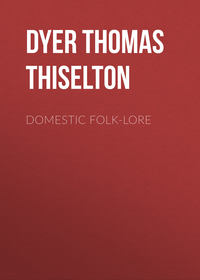 полная версия
полная версияFolk-lore of Shakespeare
847
Nares’s “Glossary,” vol. ii. p. 661; see Douce’s “Illustrations of Shakespeare,” 1839, pp. 90, 91, 109; Brand’s “Pop. Antiq.,” vol. iii. p. 111.
848
It also meant a warlike engine, as in “Coriolanus,” v. 4: “When he walks, he moves like an engine, and the ground shrinks before his treading;” so, also, in “Troilus and Cressida,” ii. 3.
849
See Dyce’s “Glossary,” p. 49; Halliwell-Phillipps’s “Handbook Index to Shakespeare,” p. 56; Nares’s “Glossary,” vol. i. p. 104.
850
It is reprinted in Hawkins’s “English Drama,” 1773.
851
“Illustrations of Shakespeare,” pp. 263. 264; see Dyce’s “Glossary,” p. 423.
852
See “Book of Days,” vol. i. pp. 598, 599.
853
Nares’s “Glossary,” vol. ii. p. 965.
854
“Callat,” an immodest woman, also applied to a scold. Cf. “Winter’s Tale,” ii. 3:
“A callat Of boundless tongue, who late hath beat her husband, And now baits me.”
855
Skimmington was a burlesque ceremony in ridicule of a man beaten by his wife. See Brand’s “Pop. Antiq.,” vol. ii. pp. 191, 192.
856
“Shakespeare Proverbs,” 1858.
857
Bohn’s “Handbook of Proverbs,” p. 159.
858
Ibid. p. 94.
859
“Shakespeare and the Emblem Writers,” 1870, p. 341.
860
See Kelly’s “Proverbs of All Nations,” 1870, p. 157.
861
Halliwell-Phillipps’s “Handbook Index to Shakespeare,” p. 390, under Proverbs.
862
See Kelly’s “Proverbs of All Nations,” p. 91.
863
Halliwell-Phillipps’s “Handbook Index to Shakespeare,” p. 391.
864
See Bohn’s “Handbook of Proverbs,” p. 326.
865
See Bohn’s “Handbook of Proverbs,” p. 333; Kelly’s “Proverbs of all Nations,” 1870, p. 173.
866
Halliwell-Phillipps’s “Handbook Index to Shakespeare,” p. 391.
867
Bohn’s “Handbook of Proverbs,” p. 86.
868
Ray gives another form: “Every man is either a fool or a physician after thirty years of age;” see Bohn’s “Handbook of Proverbs,” 1857, p. 27.
869
“Illustrations of Shakespeare,” p. 199.
870
See Green’s “Shakespeare and the Emblem Writers,” 1870, pp. 319, 323.
871
Halliwell-Phillipps’s “Handbook Index to Shakespeare,” p. 391.
872
Kelly’s “Proverbs of All Nations,” 1872, p. 52.
873
Ibid., 1870, pp. 175, 176.
874
See Bohn’s “Handbook of Proverbs,” p. 100; Kelly’s “Proverbs of All Nations,” p. 187.
875
Halliwell-Phillipps’s “Handbook Index to Shakespeare,” p. 392.
876
See Kelly’s “Proverbs of All Nations,” 1870, pp. 196, 197.
877
Halliwell-Phillipps’s “Handbook Index to Shakespeare,” p. 392.
878
See page 394.
879
“Handbook Index to Shakespeare,” p. 392.
880
Bohn’s “Handbook of Proverbs,” 1857, p. 409.
881
A shaft is an arrow for the longbow, a bolt is for the crossbow. Kelly’s “Proverbs of All Nations,” p. 155.
882
“But now consider the old proverbe to be true, yt saieth that marriage is destinie.” – Hall’s “Chronicles.”
883
See Bohn’s “Handbook of Proverbs,” p. 116.
884
See Bohn’s “Handbook of Proverbs,” pp. 160, 251.
885
See Dyce’s “Glossary,” p. 323.
886
Halliwell-Phillipps’s “Handbook Index to Shakespeare,” p. 393.
887
“Illustrations of Shakespeare,” p. 333.
888
See page 332.
889
Brewer’s “Dictionary of Phrase and Fable,” p. 860.
890
Ray’s “Proverbs” (Bohn’s Edition), 1857, p. 76.
891
Kelly’s “Proverbs of All Nations,” p. 80.
892
See page 385.
893
See Bohn’s “Handbook of Proverbs,” p. 115.
894
“Shakespeare and his Times,” vol. i. p. 216.
895
See Kelly’s “Proverbs of All Nations,” p. 49.
896
“Handbook Index to Shakespeare,” p. 395.
897
See Bucknill’s “Medical Knowledge of Shakespeare,” p. 120.
898
Mr. Singer, in a note on this passage, says, “It was customary, in the East, for lovers to testify the violence of their passion by cutting themselves in the sight of their mistresses; and the fashion seems to have been adopted here as a mark of gallantry in Shakespeare’s time, when young men frequently stabbed their arms with daggers, and, mingling the blood with wine, drank it off to the healths of their mistresses.” – Vol. ii. p. 417.
899
“Illustrations of Shakspeare,” 1839, p. 156.
900
“Medical Knowledge of Shakespeare,” p. 124.
901
Cf. “Tempest,” v. 1:
“the ignorant fumes that mantle Their clearer reason.”
902
Clark and Wright’s “Notes to Macbeth,” 1877, p. 101.
903
Singer’s “Shakespeare,” vol. viii. p. 123.
904
“Vulgar Errors,” book v. chap. 23 (Bohn’s edition, 1852, vol. ii. p. 82).
905
Prynne attacked the fashion in his “Unloveliness of Love-locks.”
906
See Douce’s “Illustrations of Shakespeare,” pp. 165, 166.
907
Ibid. p. 273.
908
See “Romeo and Juliet” (iii. 5), where Capulet says, “My fingers itch,” denoting anxiety.
909
See Nares’s “Glossary,” vol. i. p. 44.
910
See Brand’s “Pop. Antiq.,” 1849, vol. iii. p. 249; Jones’s “Credulities Past and Present,” pp. 529-531; “Notes and Queries,” 5th series, vol. viii. p. 201.
911
The following is from Holinshed, who copies Sir Thomas More: “In riding toward the Tower the same morning in which he (Hastings) was beheaded his horse twice or thrice stumbled with him, almost to the falling; which thing, albeit each man wot well daily happeneth to them to whome no such mischance is toward; yet hath it beene of an olde rite and custome observed as a token oftentimes notablie foregoing some great misfortune.”
912
See Nares’s “Glossary,” vol. i. p. 127; Dyce’s “Glossary,” pp. 61, 230.
913
The quartos of 1602 read “a kane-coloured beard.”
914
See Jaques’s Description of the Seven Ages in “As You Like It,” (ii. 6).
915
“Parnassus Biceps,” 1656.
916
See Brand’s “Pop. Antiq.,” 1849, vol. iii. p. 179.
917
“Glossary,” vol. ii. p. 871.
918
Ibid. vol. i. p. 402.
919
See page 218.
920
Cf. “Antony and Cleopatra” (i. 2):
“Soothsayer. You shall be more beloving, than belov’d. Charmian. I had rather heat my liver with drinking.”
921
“Illustrations of Shakespeare,” 1839, pp. 38, 39.
922
See Brand’s “Pop. Antiq.,” 1849, vol. iii. pp. 252-255.
923
See Harting’s “Ornithology of Shakespeare,” 1871, p. 3.
924
“The Antiquary,” 1881, vol. iv. p. 193.
925
Ibid.
926
Nares’s “Glossary,” vol. i. p. 175.
927
“Handbook Index to the Works of Shakespeare,” 1866, p. 119.
928
See a note in Dyce’s “Glossary,” p. 112.
929
Nares’s “Glossary,” vol. ii. p. 518.
930
See “British Popular Customs,” pp. 494, 495.
931
See “Book of Days,” vol. ii. pp. 612-614.
932
Nares’s “Glossary,” vol. ii. p. 565; see Brand’s “Pop. Antiq.,” 1849, vol. iii. pp. 411-414.
933
“History of Sign-boards,” 1866, p. 226.
934
Wright’s “Notes to King Lear,” 1877, p. 133.
935
“Travels,” 1673, p. 105.
936
Cf. “King Lear,” iv. 2; “Troilus and Cressida,” v. 5; “All’s Well that End’s Well,” iv. 3.
937
Pettigrew’s “Medical Superstitions,” p. 48.
938
“French and English Dictionary;” see Dyce’s “Glossary to Shakespeare,” p. 316; Nares describes it as “a bandage, tied on for magical purposes, from περιάπτω;” see Brand’s “Pop. Antiq.,” 1849, vol. iii. pp. 324-326; Douce’s “Illustrations of Shakespeare,” 1839, pp. 305-307.
939
“Medical Superstitions,” p. 55.
940
See, under Rat, a similar superstition noticed.
941
“Shakespeare and his Times,” p. 355.
942
See Brand’s “Pop. Antiq.,” 1849, vol. iii. pp. 127-141.
943
See p. 283.
944
See Malone’s “Variorum Shakespeare,” 1821, vol. ii. p. 90.
945
See Singer’s “Shakespeare,” vol. vi. p. 167.
946
See Nares’s “Glossary,” vol. ii. p. 765.
947
“Fairy Queen,” bk. iii. c. 2; see Singer’s “Shakespeare,” vol. ix. p. 82.
948
Boisteau’s “Theatrum Mundi,” translated by John Alday (1574).
949
1849, vol. iii. pp. 60, 61.
950
See Hardwick’s “Traditions, Superstitions, and Folk-Lore,” 1872, pp. 197, 224.
951
The addition in brackets is rejected by the editors of the Globe edition.
952
Cf. “Measure for Measure,” ii. 2, iii. 1; “Much Ado About Nothing,” v. 1; “Loves Labour’s Lost,” iii. 1.
953
See Brand’s “Pop. Antiq.,” 1879, vol. i. pp. 44-51; Jones’s “Credulities Past and Present,” pp. 493-507; Hampson’s “Œvi Medii Kalendarium,” vol. i. p. 210; see an article on “Day Fatality” in John Aubrey’s “Miscellanies.”
954
See Kelly’s “Notices Illustrative of the Drama and Other Amusements at Leicester,” 1865, pp. 116, 118.
955
Drake’s “Shakespeare and his Times,” p. 352.
956
“Traditions, Superstitions, and Folk-Lore,” p. 81.
957
“Glossary,” vol. ii. p. 974.
958
See Brand’s “Pop. Antiq.,” 1849, vol. iii. pp. 229-231.
959
“Folk-Lore of Northern Counties,” 1849, p. 57.
960
Nares’s “Glossary,” vol. i. p. 68.
961
See Brand’s “Pop. Antiq.,” 1849, vol. iii. pp. 220-225; also, Harland and Wilkinson’s “Lancashire Folk-Lore,” 1867, p. 44.
962
Dyce’s “Glossary,” p. 379.
963
See Douce’s “Illustrations of Shakespeare,” pp. 65, 66.
964
We may compare, too, what Coriolanus says (ii. 3): “I will, sir, flatter my sworn brother, the people.”
965
Cf. “Romeo and Juliet,” i. 1; “As You Like It,” v. 2.
966
See Singer’s “Shakespeare,” vol. viii. p. 204.
967
See Douce’s “Illustrations of Shakespeare,” p. 133.
968
See an article by Mr. Black, in Antiquary, 1881, vol. iii.
969
See Henderson’s “Folk-Lore of the Northern Counties,” pp. 34, 35.
970
Gifford’s note on “Massinger’s Works,” 1813, vol. i. p. 170; see Dyce’s “Glossary to Shakespeare,” pp. 269, 380.
971
See Dyce, vol. iv. p. 395.
972
Staunton’s “Shakespeare,” vol i. p. 257.
973
“Guide into Tongues,” 1607.
974
See Dyce’s “Glossary,” p. 343.
975
Dyce’s “Glossary,” p. 402.
976
Ibid., vol. vi. p. 45.
977
Ibid., p. 43.
978
“Glossary,” p. 497; see Nares’s “Glossary,” vol. ii. p. 952.
979
“Encyclopædia Britannica,” 1879, vol. ix. p. 366; see Doran’s “History of Court Fools,” 1858.
980
Nares’s “Glossary,” vol. i. p. 350.
981
Nares’s “Glossary,” vol. i. p. 371.
982
The verb “to gage,” or “to pledge,” occurs in “Merchant of Venice,” i. 1:
“but my chief care Is, to come fairly off from the great debts Wherein my time, something too prodigal, Hath left me gaged.”
983
“Pop. Antiq.,” vol. ii. p. 127.
984
“Glossary,” vol. ii. p. 858; see Dyce’s “Glossary,” p. 431.
985
A Welsh hook was a sort of bill, hooked at the end, and with a long handle. See Dyce’s “Glossary,” p. 497; and Singer’s “Shakespeare,” vol. ix. p. 168.
986
Brewer’s “Dictionary of Phrase and Fable,” p. 782.
987
See Percy’s “Northumberland Household Book,” p. 49.
988
See Singer’s “Shakespeare,” vol. vii. p. 350.
989
“Shakespeare,” 1864, vol. i. p. 61.
990
See page 312.





